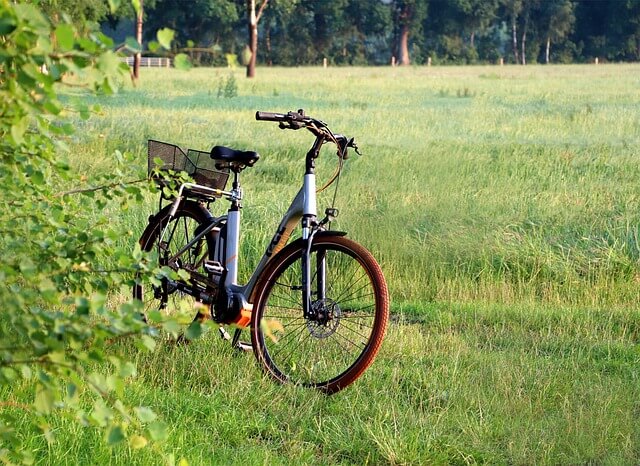E-bikes, bicycles equipped with electric motors, are transforming the cycling landscape. Offering effortless riding, extended range, and a convenient, eco-friendly way to get around, e-bikes cater to diverse needs and fitness levels. From conquering hills and exploring further to commuting comfortably and staying active, e-bikes open up a world of possibilities for everyone. This blog delves into the exciting world of e-bikes, exploring their benefits, different types, and how they can revolutionize your cycling experience.
Key Features to Consider When Buying an E-Bike
Beyond the basic understanding of e-bikes, choosing the right one for you involves delving into key features that impact your riding experience and needs. Here’s a breakdown of crucial factors to consider:
Battery Life and Charging Time: Battery capacity, measured in watt-hours (Wh), determines your e-bike’s range per charge. Consider your typical riding distance and choose a battery capacity that offers a comfortable buffer. Charging time also plays a role, with faster charging being more convenient but potentially affecting battery lifespan.
Motor Type and Power Output: E-bike motors come in various types, from hub-mounted for efficiency to mid-drive for better weight distribution and handling on tougher terrain. Motor power output, measured in watts, determines the level of assistance provided. Higher wattage offers more power for tackling hills or maintaining higher speeds.
Frame Material and Design: Frame materials like aluminum offer a lightweight and durable option, while steel provides sturdiness. The frame design also impacts comfort and handling. Consider upright styles for leisurely rides or step-through frames for easier mounting and dismounting.
Weight and Portability: E-bikes are inherently heavier than regular bikes due to the motor and battery. Choose a weight manageable for your needs, especially if you plan to lift or store the bike frequently. Look for features like removable batteries or folding frames for added portability.
Range and Speed Capabilities: E-bike range depends on battery capacity, motor power, and terrain. Choose a range that exceeds your typical riding distance to avoid unexpected battery depletion. Top speed capabilities vary depending on the model, with some offering higher speeds for riders seeking a more performance-oriented experience.
Understanding E-Bike Regulations: Navigating the Legal Landscape
While e-bikes offer a thrilling and convenient way to get around, it’s crucial to familiarize yourself with the legal framework surrounding their use. E-bike regulations vary significantly by region and country, impacting factors like:
Legal Restrictions and Age Requirements:
- Age Limits: Minimum age requirements for e-bike operation often align with those for regular bicycles, but exceptions may exist.
- Restrictions on Use: Some areas might restrict e-bikes from specific zones like sidewalks, pedestrian areas, or designated bike paths.
Licensing, Registration, and Insurance Needs:
- Licensing: Depending on the jurisdiction, e-bike riders might require a driver’s license or specific e-bike permits.
- Registration: Similar to traditional vehicles, e-bikes might need registration with local authorities.
- Insurance: While not always mandatory, e-bike insurance is highly recommended to protect yourself and others in case of accidents.
Differences in E-Bike Laws by Region or Country:
- Classification Systems: E-bikes are often categorized based on motor power, speed capabilities, and pedal-assist functionality. These classifications determine the applicable regulations.
- Speed Limits: Maximum speed limits for e-bikes vary considerably, with some areas imposing lower limits compared to regular bicycles.
- Safety Requirements: Specific safety equipment like helmets might be mandatory for e-bike riders in certain regions.
How to Choose the Right E-Bike
With the vast array of e-bikes available, selecting the perfect one requires careful consideration of your intended use and personal preferences. Here’s a breakdown of key factors to guide your decision:
Assessing Your Needs:
- Commuting: Prioritize comfort, weather protection, and sufficient range for your daily commute. Consider features like integrated lights and pannier racks for added convenience.
- Recreation: For leisurely rides and exploring new trails, focus on comfort, handling, and a range suitable for your planned outings. Look for features like adjustable handlebars and suspension for a smoother ride.
- Off-roading: For tackling challenging terrain, prioritize a sturdy frame, powerful motor, and wider tires with knobby treads for better traction. Suspension systems and a lower center of gravity enhance control on rough terrain.
Importance of Trying Before Buying:
No matter your chosen category, taking multiple e-bikes for test rides is crucial. This allows you to:
- Feel the difference: Experience how various motor types, power outputs, and frame geometries impact handling and comfort.
- Evaluate fit: Ensure proper frame size and handlebar/seat adjustments for a comfortable and safe riding position.
- Test the features: Experiment with different pedal-assist levels, braking systems, and other functionalities to find what suits you best.
Recommendations for Beginners vs. Experienced Riders:
- Beginners: Opt for user-friendly models with intuitive controls, lower motor power for easier control, and comfortable upright riding positions. Consider features like step-through frames for easier mounting and dismounting.
- Experienced Riders: Explore e-bikes with higher motor power for tackling steeper hills or achieving higher speeds. Consider features like mid-drive motors for better weight distribution and advanced suspension systems for technical terrain.
Make this Mother’s Day unforgettable with up to $800 off all HAOQI electric bikes, plus a $359 gift with your purchase! Explore our range of premium e-bikes designed for every adventure.
HAOQI Rhino Electric Motorbike
HAOQI Squirrel Folding Electric Bike
HAOQI Green Leopard Pro Fat Tire Electric Bike
HAOQI White Leopard Pro Step Thru Electric Bike
HAOQI Black Leopard Pro Fat Tire Electric Bike
HAOQI Silver Antelope Pro 750W Cargo Electric Bike
HAOQI Antelope Pro 750W Cargo Electric Bike
HAOQI Antelope 500W Cargo Electric Bike
HAOQI Camel Electric Cargo Bike
HAOQI Upgraded Eagle Long Range Electric Bicycle
HAOQI Eagle Long Range Electric Bicycle
HAOQI Cheetah Pro Mid-Drive Full Suspension Ebike
HAOQI Cheetah Full Suspension Electric Bike – Dual Battery Version Available
HAOQI Cheetah Full Suspension Electric Bike – Dual Battery Version Available
Where to Buy E-Bikes
When it comes to acquiring your dream e-bike, the online world offers a wealth of possibilities. While traditional bike shops have their advantages, the convenience and benefits of buying an e-bike online are undeniable:
Unbeatable Selection and Price: Online platforms showcase a vast array of e-bikes from various brands and models, often at more competitive prices. You can easily compare features, specifications, and customer reviews to find the perfect match for your needs without geographical limitations.
Effortless Shopping Experience: Skip the hassle of visiting multiple stores and navigating crowds. Browse through online catalogs at your own pace, research specific models, and make informed decisions from the comfort of your home.
Direct-to-Consumer Savings: Online e-bike retailers often operate with lower overhead costs compared to brick-and-mortar stores. This translates to potential savings for you, allowing you to access high-quality e-bikes at more affordable prices.
Free Shipping and Assembly Options: Many online e-bike retailers offer free shipping directly to your doorstep, eliminating the need for transportation or heavy lifting. Some even provide assembly services, ensuring your e-bike is ready to ride upon arrival.
Detailed Information and Reviews: Online platforms often provide comprehensive product descriptions, specifications, and high-quality images, allowing you to thoroughly analyze each e-bike before making a purchase. Additionally, customer reviews offer valuable insights into real-world experiences and can help you make a confident decision.
Convenient Return Policies: Most online e-bike retailers offer hassle-free return policies, providing peace of mind in case the e-bike doesn’t meet your expectations.
Supporting Innovation: By choosing to buy e-bikes online, you’re directly supporting online businesses that are often at the forefront of innovation and offer a wider range of e-bike models compared to traditional stores.
Maintenance and Care for E-Bikes: Keeping Your Electric Companion in Top Shape
While e-bikes offer a convenient and enjoyable riding experience, proper maintenance is crucial for ensuring their longevity and optimal performance. Here’s a breakdown of key care practices:
Routine Maintenance Tasks:
- Regular Cleaning: Regularly wash your e-bike with a damp cloth and mild soap to remove dirt and debris. Avoid using high-pressure water jets that could damage electrical components.
- Lubrication: Apply lubricant to the chain, cassette, and other moving parts as recommended by the manufacturer. This reduces friction and wear, ensuring smooth operation.
- Tire Pressure: Check and adjust tire pressure regularly for optimal grip, handling, and comfort. Refer to the recommended pressure indicated on the tire sidewall.
- Brake Maintenance: Inspect brake pads for wear and tear, and replace them when necessary. Ensure proper brake alignment and functionality for safe riding.
- Bolt Tightness: Periodically check all bolts and nuts for tightness to prevent loosening and potential damage.
Long-Term Storage Tips:
- Battery Care: Store the battery in a cool, dry place with a partial charge (around 50%). Avoid extreme temperatures and direct sunlight, which can degrade battery life.
- Clean and Dry: Clean and dry the entire bike before long-term storage to prevent rust and corrosion.
- Safe Storage: Store your e-bike in a secure and dry location, ideally indoors or covered to protect it from the elements.
Common Issues and Troubleshooting:
- Motor or Battery Issues: Consult the user manual or seek professional assistance for troubleshooting motor or battery problems. Avoid attempting repairs yourself unless you have the necessary expertise.
- Flat Tire: Carry a spare tube and tire repair kit to address flat tires on the go.
- Shifting Problems: Adjust the derailleur or consult a mechanic if shifting gears becomes difficult.
Conclusion
By following these simple maintenance practices, you can ensure your e-bike runs smoothly, efficiently, and safely for years to come. Remember, regular care not only extends the lifespan of your e-bike but also enhances your riding experience.
Recap of Key Points:
- Regular cleaning, lubrication, and tire pressure checks are essential.
- Proper battery care and storage are crucial for maximizing battery life.
- Addressing minor issues promptly prevents further damage.
- Consider professional assistance for complex repairs.
Encouragement to Consider an E-Bike:
E-bikes offer a sustainable and efficient transportation option, encouraging a healthier lifestyle and reducing reliance on cars. With proper care and maintenance, your e-bike can become a reliable and enjoyable companion for years to come. So, embrace the electric revolution and experience the joy of e-biking!
E-Bike FAQs: Your Top Questions Answered
- How far can an e-bike travel on a single charge?
The range of an e-bike depends on several factors, including battery capacity, terrain, riding style, and rider weight. Generally, e-bikes offer a range of 50-100km, but this can vary significantly. Larger batteries and flatter terrain will extend the range, while hills and headwinds will deplete the battery faster.
- Do I need a license or insurance to ride an e-bike?
No, in most countries and regions, you don’t need a special license to operate an e-bike. However, regulations can vary, so it’s important to check your local laws. E-bike insurance is not mandatory but highly recommended for protection in case of accidents.
- How fast can e-bikes go?
Most e-bikes have a legal speed limit of 25km/h (15mph) with pedal-assist. You can still pedal faster, but the motor assistance cuts out at this speed. Some e-bikes designed for off-road use might have higher top speeds, but these often require additional registration or licensing.
- Are e-bikes difficult to maintain?
E-bikes require similar maintenance as regular bicycles, including regular cleaning, lubrication of the chain and drivetrain, and checking tire pressure. The battery might require specific care like avoiding extreme temperatures and storing it partially charged.
- Are e-bikes a good option for exercise?
While e-bikes offer pedal-assist, they still provide a physical workout. You can adjust the level of assistance to control the intensity of your ride. This makes e-bikes a great option for people who want to enjoy cycling but might struggle with hills or longer distances on a regular bike.















